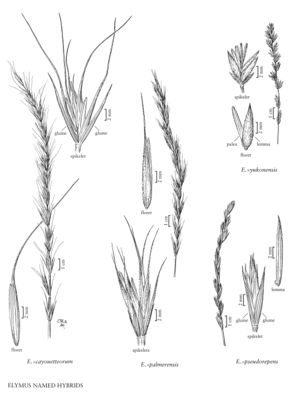Elymus ×palmerensis
Plants densely cespitose, shortly rhizomatous. Blades (2) 4-8 (15) mm wide, abaxial surfaces scabrous, adaxial surfaces pilose. Spikes 14-30 cm long, 1-2.5 cm wide including the awns, 0.3-0.8 (1.5) cm wide excluding the awns, drooping, with 1-2 spikelets per node; internodes 5-20 mm, scabrous on the angles. Spikelets with 3-9 florets. Glumes 4-10.5 mm long, 0.8-1.5 mm wide, oblong to lanceolate, scabrous, gradually or abruptly narrowing in the distal 1/3-1/4, 3 (4) -veined, margins scarious, apices unawned or awned, awns to 15 mm; rachillas hairy; lemmas 8.5-15 mm, hairy, conspicuously keeled distally, awned, awns 3-10 mm; paleas 8.5-15 mm, retuse or truncate; anthers 1-2 mm.
Discussion
Elymus ×palmerensis is the name for hybrids between E. macrourus (p. 324) and E. sibiricus (p. 310). It is known from disturbed sites around Palmer, Alaska, and in south-central Alaska. Bowden (1967) also reported it from Fort Liard, in the MacKenzie District, Northwest Territories. Lepage (1952) originally identified the parents as Agropyron sericeum [= E. macrourus] and E. canadensis (p. 303). Later, Lepage (1965) stated that the second parent was E. sibiricus. The above description includes ×Agroelymus hodgsonii Lepage, which, according to Bowden (1967), is a synonym.
Elymus ×palmerensis is an Elymus named hybrid
Elymus is notorious for its ability to hybridize. Most of its interspecific hybrids are partially fertile, permitting introgression between the parents. The descriptions provided below are restricted to the named interspecific hybrids. They should be treated with caution and some skepticism; some are based solely on the type specimen, because little other reliably identified material was available. Moreover, as the descriptions of the non-hybrid species indicate, many other interspecific hybrids exist.
The parentage of all hybrids is best determined in the field. Perennial hybrids, such as those in Elymus, can persist in an area after one or both parents have died out, but the simplest assumption is that both are present. Interspecific hybrids of Elymus that have disarticulating rachises presumably have E. elymoides or E. multisetus as one of their parents.
Selected References
None.
Lower Taxa
"decumbent" is not a number.
